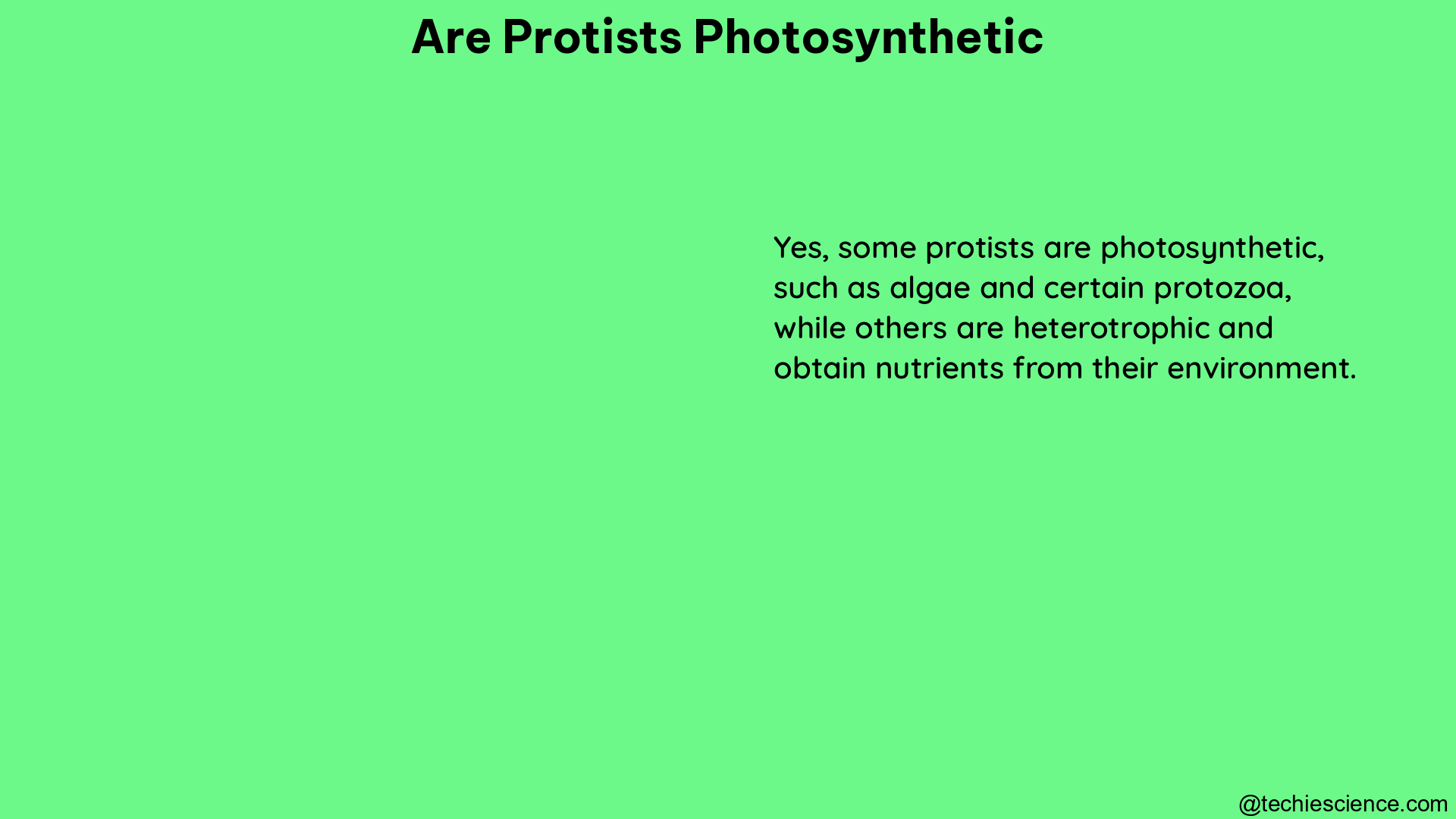Protists are a diverse group of eukaryotic organisms that play a crucial role in aquatic ecosystems and global carbon cycling. While not all protists are photosynthetic, a significant portion of them possess the ability to produce their own food through the process of photosynthesis. This blog post will delve into the intricacies of photosynthetic protists, exploring their characteristics, ecological significance, and the techniques used to study their photosynthetic activity.
Photosynthetic Protists: The Algae
Photosynthetic protists, also known as algae, are a diverse group of organisms that can be found in a wide range of aquatic environments, from freshwater lakes and rivers to the vast oceans. These protists possess chloroplasts, organelles that house the photosynthetic machinery, allowing them to convert light energy, carbon dioxide, and water into glucose and oxygen through the process of photosynthesis.
Algae can be classified into several major groups, each with its own unique characteristics:
-
Diatoms (Bacillariophyceae): Diatoms are a group of photosynthetic protists that are known for their intricate, glass-like cell walls. They are one of the most abundant and ecologically important groups of photosynthetic protists, responsible for an estimated 20-25% of global primary production.
-
Dinoflagellates (Dinophyceae): Dinoflagellates are a group of photosynthetic protists that are characterized by their two distinct flagella, which allow them to move through the water column. Some dinoflagellates, such as Gyrodinium galatheanum, exhibit mixotrophy, the ability to switch between photosynthesis and heterotrophy.
-
Green Algae (Chlorophyta): Green algae are a diverse group of photosynthetic protists that are closely related to land plants. They can be found in a variety of aquatic habitats, from freshwater to marine environments, and play a crucial role in the primary production of these ecosystems.
-
Red Algae (Rhodophyta): Red algae are a group of photosynthetic protists that are characterized by their distinctive red pigments, which are used in the process of photosynthesis. They are primarily found in marine environments and are known for their role in the formation of coral reefs.
Mixotrophy: The Ability to Switch Between Photosynthesis and Heterotrophy

One of the fascinating aspects of photosynthetic protists is their ability to exhibit mixotrophy, the capacity to switch between photosynthesis and heterotrophy (the acquisition of organic compounds from the environment). This adaptability allows protists to thrive in a wide range of environmental conditions, such as changes in light intensity and nutrient availability.
For example, the dinoflagellate Gyrodinium galatheanum has been shown to exhibit mixotrophy, with its grazing responses influenced by light intensity and inorganic nutrient levels. Similarly, planktonic diatoms, a major group of photosynthetic protists, have been found to utilize energy dissipation as a form of photoprotection, allowing them to adapt to changing light conditions.
Photosynthetic Activity and Measurement
To understand the photosynthetic activity of protists, researchers often employ techniques such as pulse amplitude modulated (PAM) fluorometry. This method allows for the quantification of the quantum yield of photosystem II, which is a measure of the efficiency of the photosynthetic process.
By using PAM fluorometry, researchers can identify factors that influence the photosynthetic activity of protists, such as light intensity and nutrient availability. This information is crucial for understanding the ecological and biogeochemical significance of photosynthetic protists in aquatic ecosystems.
Ecological and Biogeochemical Significance
Photosynthetic protists play a vital role in aquatic food webs and global carbon cycling. As primary producers, they form the base of the food chain, providing energy and nutrients to higher trophic levels. Additionally, their photosynthetic activity contributes to the drawdown of atmospheric carbon dioxide, making them an important component of the global carbon cycle.
A study of oceanic protists with different forms of acquired phototrophy found that these organisms display contrasting biogeographies and abundance, with some species being more abundant in certain regions of the ocean. This highlights the importance of understanding the distribution and abundance of photosynthetic protists in order to better predict their impact on ecosystem functioning and global biogeochemical processes.
Conclusion
Protists are a diverse group of eukaryotic organisms, and a significant portion of them possess the ability to photosynthesize. These photosynthetic protists, or algae, play a crucial role in aquatic ecosystems and global carbon cycling. Through the process of mixotrophy, many protists can adapt to changing environmental conditions, switching between photosynthesis and heterotrophy as needed.
By employing techniques such as PAM fluorometry, researchers can quantify the photosynthetic activity of protists and identify the factors that influence their productivity. Understanding the ecological and biogeochemical significance of photosynthetic protists is essential for understanding the functioning of aquatic ecosystems and the global carbon cycle.
References:
- Lavaud, J., Rousseau, B., & Etienne, A.-L. (2004). General features of photoprotection by energy dissipation in planktonic diatoms (Bacillariophyceae). Journal of Phycology, 40, 130–137. https://doi.org/10.1046/j.1529-8817.2004.03026.x
- Levinsen, H., Nielsen, T. G., & Hansen, B. W. (2000). Annual succession of marine pelagic protozoans in Disko Bay, west Greenland, with emphasis on winter dynamics. Marine Ecology Progress Series, 206, 119–134. https://doi.org/10.3354/meps206119
- Li, A., Stoecker, D. K., & Coats, D. W. (2000). Mixotrophy in Gyrodinium galatheanum (Dinophyceae): grazing responses to light intensity and inorganic nutrients. Journal of Phycology, 36, 33–45. https://doi.org/10.1046/j.1529-8817.2000.98076.x
- Leles, S. G., Mitra, A., Flynn, K. J., Stoecker, D. K., Hansen, P. J., Calbet, A., … & Jeong, H. J. (2017). Oceanic protists with different forms of acquired phototrophy display contrasting biogeographies and abundance. Proceedings of the Royal Society B: Biological Sciences, 284(1860), 20170664. https://doi.org/10.1098/rspb.2017.0664
Hi….I am Ganeshprasad DN, completed my Ph.D. in Biochemistry from Mangalore University, I intend to use my knowledge and technical skills to further pursue research in my chosen field.